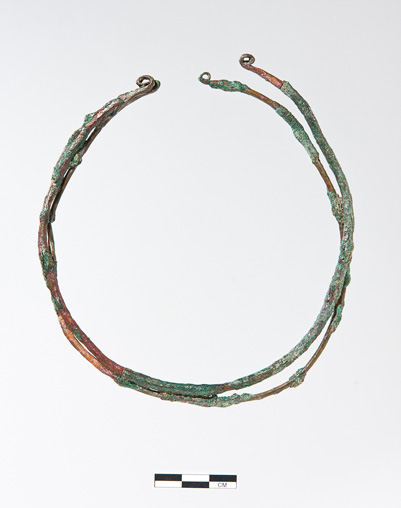
Summary
At the NW corner of the site, in a prime position overlooking the road and the river valley, we exposed a relatively large and probably public building from which came an official's stamp seal, and which very likely dates to the period of Hittite control. This is replaced, well before the collapse of the Hattusa Dynasty, by a very different building with ritual and storage functions, but yielding four official stamp seals, which strongly suggest that it was also an administrative centre. After a period of use this Stele Building was reconstructed along the same lines, and then twice destroyed by fire, the second occasion (phase IId) being dated to around 1170 BC by the Mycenaean style ceramics: this is after the fall of the Hittite Empire, but could well coincide in time with the demise of the Tarhuntassa Dynasty.
At much the same time at the centre of the mound an area of Late Bronze Age housing was replaced by less substantial architecture, and, in one phase by a large circular wooden structure. Then the area became an open space for several centuries during which we have little evidence for housing, but the local ceramics continued, being joined over time by occasional imports or imitations of Eastern Mediterranean wares which mark the gradual re-establishment of regional networks. The final pre-Classical occupation of the site is represented by an open space with ovens and a variety of storage facilities. It dates to around 700-650 BC, to judge from the ceramics recovered from the K14 sounding and from the kiln at the NW corner which points to local production of this characteristic Eastern Mediterranean ware. Whether the gap in occupation which then ensued had anything to do with the imperial ventures of the Assyrian or Neo-Babylonian kings is impossible to say: but perhaps at this juncture the local administrative centre or power base moved to present-day Mut, which later became the Roman city of Claudiopolis.
Publications
J.N. Postgate, "Identifying the end of the Hittite Empire: problems of reuniting history and archaeology at Kilise Tepe", Newsletter of the Department of Archaeology and History of Art, Bilkent University 4 (2005), 26-30.
J.N. Postgate & D.C. Thomas (eds.) Excavations at Kilise Tepe, 1994-1998: From Bronze Age to Byzantine in Western Cilicia, 2 vols. 620 + 244 pp., 527 b/w illus., 58 col. illus., 43 tables (McDonald Institute/ British Institute at Ankara 2007).
Mark Jackson & Nicholas Postgate, "Kilise Tepe 2007", Anatolian Archaeology 13 (2007), 28-30.
J.N. Postgate, "The ceramics of centralization and dissolution: a case study from Rough Cilicia", Anatolian Studies 57 (2007), 141-150.
J.N. Postgate, "The chronology of the Iron Age seen from Kilise Tepe", Ancient Near Eastern Studies 45 (2008) 166-187.
Mark Jackson & Nicholas Postgate, "Kilise Tepe 2008", Anatolian Archaeology 14 (2008), 23-24.
P. Baker, "Economy, environment and society at Kilise Tepe, southern central Turkey. Faunal remains from the 1994-1998 excavations", in Archaeozoology of the Near East, VIII (Lyon 2008), 407-429.
M.P.C. Jackson & J.N. Postgate, "Excavations at Kilise Tepe 2007", 30. Kazı Sonuçları Toplantısı (Ankara: 2009), 3. cilt, 207-232.
Mark Jackson & Nicholas Postgate, "Kilise Tepe 2009", Anatolian Archaeology 15 (2009), 21-23.
D. Collon, M.P.C. Jackson & J.N. Postgate, "Excavations at Kilise Tepe 2008", 31. Kazı Sonuçları Toplantısı (Ankara: 2010), 1. cilt, 159-184.
S. Debruyne, "Tools and Souvenirs: The Shells from Kilise Tepe (1994-1998)", Anatolian Studies 60 (2010), 149−160.
M. Egetmeyer & P.M. Steele, "A new archaic and possibly Cypriot inscription from Cilicia", Kadmos 49 (2010), 127-132.
Mark Jackson and Nicholas Postgate, " Excavations at Kilise Tepe 2009", 32.Kazı Sonuçları Toplantısı (Ankara: 2010), 3. cilt, 424-439.
N. Sykes, R.F. Carden and K. Harris, "Changes in the size and shape of fallow deer - evidence for the movement and management of a species.", International Journal of Osteoarchaeology (2011) and Wiley Online Library DOI: 10.1002/oa.1239
T.E.Şerifoğlu, "Kilise Tepe Erken Tunç Çağı Çalışmaları", 33.Kazı Sonuçları Toplantısı (Ankara: 2012), 1.cilt, 375-388.
C. Bouthillier, C. Colantoni, S. Debruyne, C. Glatz, M.M. Hald, D. Heslop, E. Kozal, B. Miller, P. Popkin, N. Postgate, C.S. Steele & A. Stone, “Further work at Kilise Tepe, 2007-2011: refining the Bronze to Iron Age transition”, Anatolian Studies 64 (2014), 95-161.
S. Blakeney, P. Boyes, C. Colantoni, S. Debruyne, M. Dee, Y. Heffron, D. Heslop, T. Higham, N. MacSweeney, R. Miller, T.E. Şerifoǧlu, C.S. Steele, and A.B. Stone; ed. J.N. Postgate Excavations at Kilise Tepe 2007-2011: The Late Bronze and Iron Ages. On-line at: https://tinyurl.com/kilisetepe.

